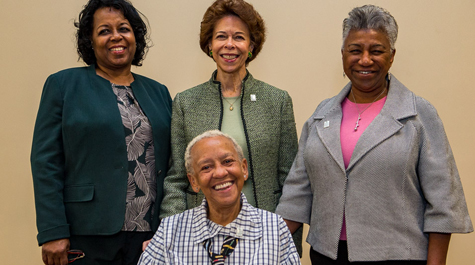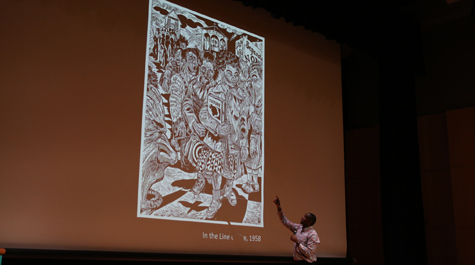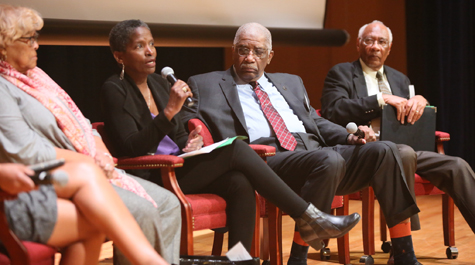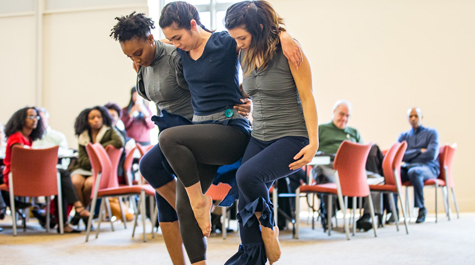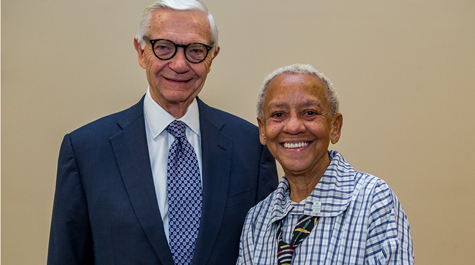Nikki Giovanni headlines Lemon Project Symposium
People of all ethnicities seem to forget that the first Africans brought to America contributed far more than just free, forced labor, poet and historian Nikki Giovanni told her audience at the Lemon Project and 50-year Commemoration Symposium at William & Mary on Saturday.
That’s a mistake that should be corrected.
“These are going to be great people, and it is time we recognized their greatness,” she said. “These are people who are going to build a nation, because no matter what we think about this country called America, it wouldn’t be diddly-squat without black people.”
Giovanni, a distinguished university professor at Virginia Tech who has authored more than 27 poetry collections, seven albums, four collections of essays or memoirs and been given the keys to the cities of New York, Miami, Los Angeles and New Orleans, delivered the keynote address at the eighth annual symposium. This year’s symposium also recognized the 50th anniversary of the university’s first African-American residential students, which is being commemorated throughout the 2017-18 academic year with a series of special events and programs.
{{youtube:medium|Fb1Pc0lWWkk,SoHHL hosts an open-mic night as part of the Lemon Project Symposium.}}
The Lemon Project, named for a man who was once enslaved by William & Mary, took shape in 2009. After student and faculty resolutions calling for a full investigation of the university’s past, the Board of Visitors acknowledged that W&M had “owned and exploited slave labor from its founding to the Civil War; and that it had failed to take a stand against segregation during the Jim Crow Era.”
As a result, the board offered its support for the establishment of The Lemon Project: A Journey of Reconciliation.
In remarks prior to Giovanni’s address, W&M President Taylor Reveley acknowledged that reconciliation is a work in progress.
“For generations, William & Mary’s relationship with the community has not been good,” he said. “We are remembering the past in order to learn from it, to find a way to become a more inclusive society than we are now. The Lemon Project is a crucial means to this end.”
Among the panels and presentations was a lecture by artist Steve Prince, a discussion of William & Mary in the community and a performance by three of Associate Professor of Dance Leah Glenn’s alumnae – Olivia Armstrong ’14, Kayla Moore ’13 and Arisa Smith ’17.
Giovanni opened by reminding the audience “white guys didn’t wake up one morning and say, ‘Let’s go to Africa and start a slave trade.’ It didn’t happen. We know that whatever those guys were, they went to Africa and became a part of a slave trade that was going on, that’s still going on. And that’s something we have to deal with. Somebody sold us, and somebody bought us.”
She detailed how the captured men and women were stacked “head to toe, head to toe” in the hold of the ship, how they were brought to the deck and “cleansed” and made to “dance” by whipping. She detailed that many were killed in unsuccessful rebellion attempts.
But out of that misery, she said, black women initiated the first attempt at having disparate captives with different languages communicate as a means of some small comfort.
“This woman underneath the ship is going to have to find a way to talk to her people, and there is no language that she had. So she’s going to do something that’s incredibly important. She’s going to hum, because that’s what she has, a song, a song that she has to invent. She’s going to moan, and her people are going to respond to that moan.”
In time, she said, African Americans introduced the world to music – the moan, the spiritual, jazz, the blues “and whatever it is that you’re hearing now. We created it.”
“It’s time we admit that what has made this country whatever it is we have decided to be a part of,” she said. “We have brought some love. We have brought something wonderful, forgiveness.
“There is another story to be told, another story that you and I who are black are going to have to find about what it means to be black in this country. It’s good that we remember what we contributed, we remember what we have done to make this a better place – and we should take credit for doing that.”
 Skip to main content
Skip to main content

